You’re liable to get fat, if you eat too many of these delicious buns.
Besides Kampua Mee, Sibu is known for another favorite Foochow food: Kompia buns. These crusty baked buns are dense like a bagel but not as chewy. They come either plain or baked with sesame seeds. Kompia are made simply with wheat flour, water, salt and a little baking soda, yet they are simply addictive!
Legendary Buns
Legend has it that a Chinese general named JiGuang, looking to feed his soldiers in Fujian province with something quick to make and easy to carry into battle, commissioned these buns to be made. There is a hole in the middle of these buns so that they can be strung together and worn around the neck. When a soldier gets hungry, he can just pull one off and eat on the run!
In honor of the general, the buns were named “Guang Ping” (or “Kompia” in the Foochow dialect). Many Foochows later came to settle in the Sibu area of Sarawak, bringing along some of their favorite foods like these kompia buns.
Happening
Our good friend and Sibu host, Mike, took us walking the streets and alleys just nearby the Sibu Central Market. Venturing down on cramped and dimly lit alley, we happened upon this small shop selling kompia and other baked goods. The proprietor was busily working inside, preparing the dough for baking.
First, he took a thick rope of dough and snapped off equal sized balls. Working with a one-handled rolling pin, he first rolled the ball into a thick disc, flipped it over, then rolled it a second time. He next pressed the point of the handle into the center of the disc to make the hole, then deftly slid the disc out of the way while reaching for the next ball.
He did this maneuver dozens of times until all the balls were rolled out.
Once they were rolled out and arranged, he sprayed them with a misting of water and then sprinkled on a generous helping of sesame seeds.
Kompia are traditionally cooked in a charcoal-fired clay or concrete oven, similar to an Indian tandoor. After wetting his hands, the baker loaded on a few discs, then reached in to the oven to deposit them on the sides of the oven wall. He repeated this process until the entire inside was covered with buns.
The pile of lit charcoal inside the oven was ingeniously covered with a wok to keep the earlier buns from cooking and also protect the baker as he worked. Once all the buns were arranged, he removed the wok and positioned a blower fan to feed air to the coals and bring up the temperature. When the coals were burning red-hot, he covered the top of the oven to let the buns bake for about 10 minutes.
After a brief wait, it was time to check on the buns. With a long-handled basket in one hand and what looked like a small spade in the other, he reached in to the oven to knock several of the cooked buns off the wall and collect them in the basket. Then he swung them into another basket where his wife was waiting to bag them up for waiting customers.
These kompia are best eaten fresh out of the oven, when they are still a bit soft, and the intoxicating fragrance of sesame seeds wafts from the warm bun. There is a hint of smoke from the charcoal as well. The best part is the side that was sticking to the wall, which is slightly burnt and caramelized from the heat.
You can eat them plain, but a popular way of eating kompia nowadays is to slice them in half and fill them with pork (Mike has a recipe here) or other meat fillings. However you like to eat them, just be careful not to eat too many at one go!
Aloha, Nate
Other articles about kompia: Sarikei Time Capsule, Life is Like That, Sarawakiana

I am entering this article in the Muhibbah Malaysian Monday roundup for November, hosted by Shaz.

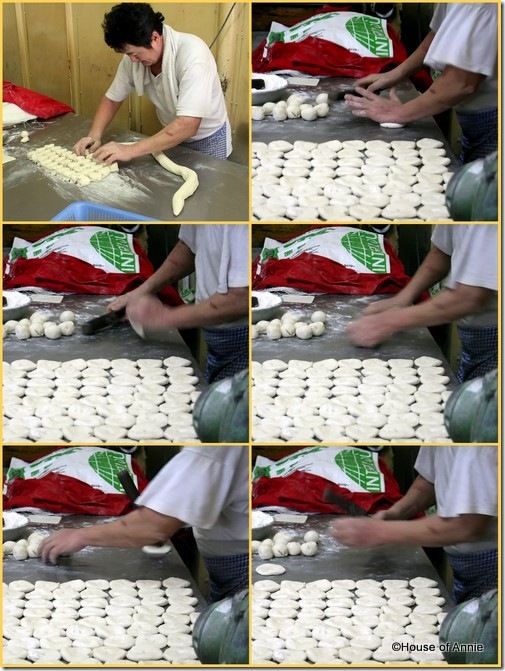
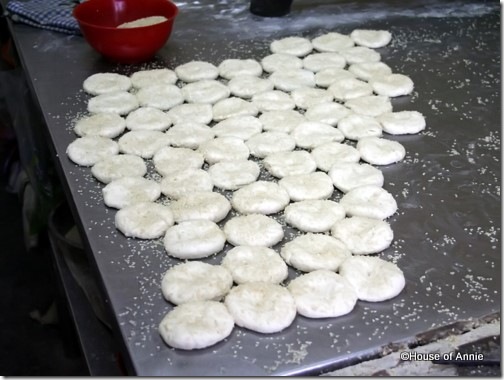
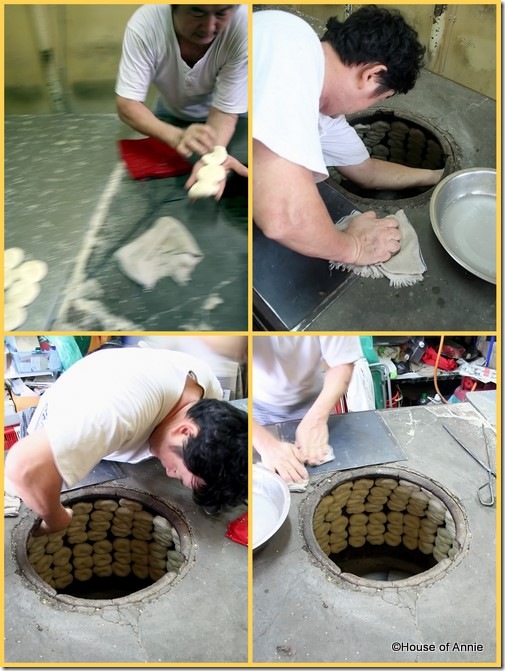
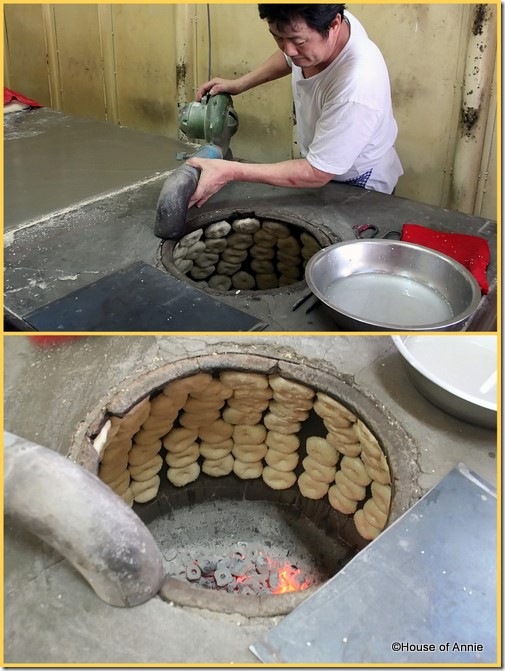
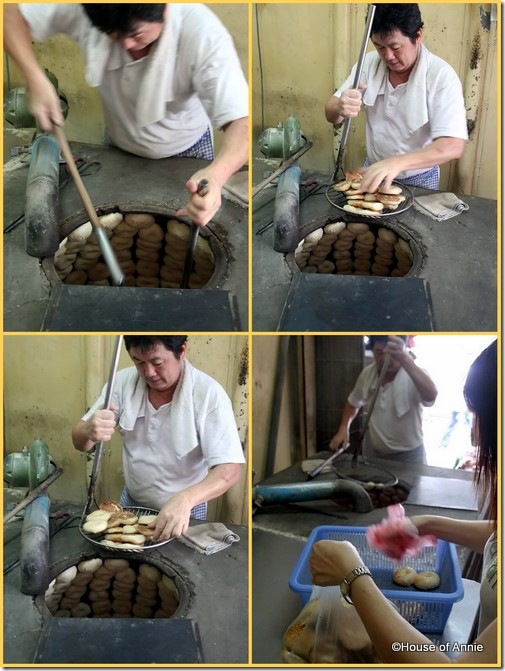
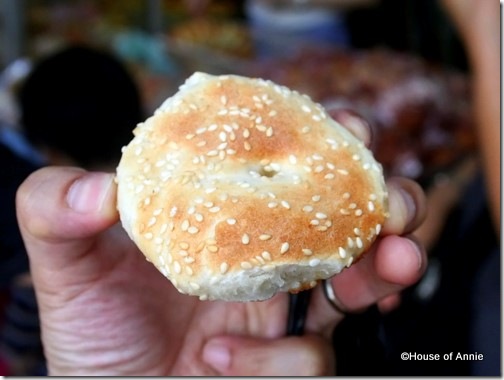
These buns look like something I will like! I actually like plain buns hehe…great photos of the process 🙂
Jen –
thanks!
How interesting! It must be fascinating to watch him make these buns. I like how he stuck the buns to the oven walls. His hands must be so seasoned that he can withstand the heat. I am sure it is still pretty hot in there even though he has that wok over the coals.
Biren –
I was enthralled, and very thankful he allowed me to snap away while he worked. You may not see it in the small pics, but he did have numerous burn marks on his arms. Brave guy!
I am feeling pretty nostalgic right now looking at all the pictures. Thank you very much for sharing! I actually did write a post on kompia/sesame bagel back in 2009 – http://simplepleasuresfmk.blogspot.com/2009/03/kompia-sesame-bagel.html, and at one point referenced Kong Kay. I didn’t realize until now that “Kong Kay” is basically your friend, Mike. What a small world. 😀
Chris –
you’re welcome!
Kong Kay aka Mike is a great cook and a really nice guy.
Hi, I’m trying to look up your link on kompia but I think it has been removed. Appreciate your help. Thanks
Wow, what an interesting way to bake these buns. How do they keep them from falling down into the charcoal? So cool. I bet it’s really tasty nice and warm. I would put jam on it. You can call it the Asian bagel almost!
Ben –
I’m not sure what kind of magic they do to make the bread stick.
Asian bagel is an apt description!
Another excellent food find. Your blog is a wonderful promotion for the cuisine of Sibu’s Foochow community.
It has also inspired me to look more closely for kompia in Manhattan’s Chinatown where there is a growing Foochow population. Will keep you posted.
Becky –
thanks! We’ve barely scratched the surface of Sibu food. Food bloggers like Kong Kay and SuiTuaPui have covered Sibu much more extensively.
I’d love to hear if you can find kompia in NYC!
Hello, you both seem to have fallen in love with the food there………..I wonder how you will manage when its time to come home…………enjoy lots while you can….:):):)
GG –
we’re wondering how we’ll be able to cope, too! We love Sarawak.
I’m hock chiew, I love Kom Pia (steel biscuit). I’m cravings for it after reading your post. Can’t wait to go back to Sitiawan just for it.
You did a thorough blog on this 🙂 I think many of us wouldn’t know how Kong Pia is made.
Chin,
thanks!
I was very grateful that the baker allowed me to record the process. He was most kind.
Finally, it is great to see one of my favourite hometown food shown here. it is one of the greatest food that you can find in Sibu. really miss them.
Thank for sharing and promoting.
Cheers.
I just came back from visiting student in Sibu last week..I make sure I didn’t miss buying kompia this time from the only Sugarbun outlet who sell Kompia..Couldn’t find the traditional Kompia baker the one used halal ingredients. But I am so happy Sugarbun took initiative to make it andfeed my hunger for Kompia…sedap..mkn cicah coffee or eat it empty…